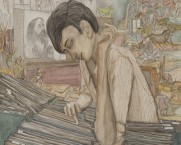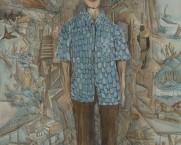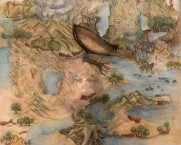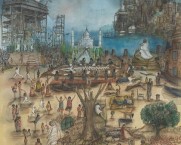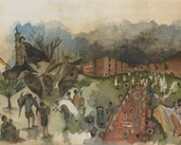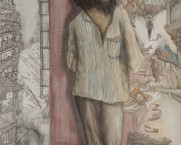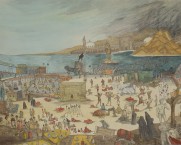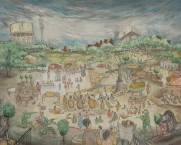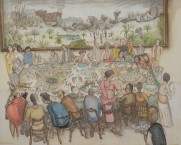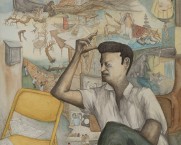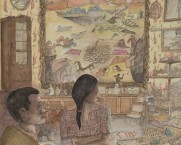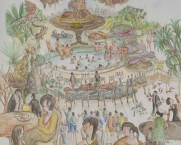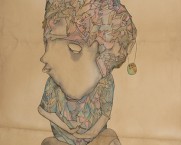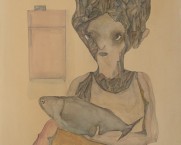C&L Shows
Wood from Ships
Nityan Unnikrishnan
2016 2017
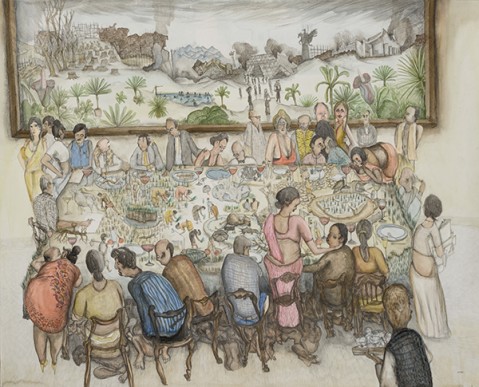
Overview
“The invention of the ship was also the invention of the shipwreck.” Paul Virilio
For a painter whose works are so replete with allusion, Nityan Unnikrishnan is notably reluctant to concede any direct references. He quails when I gesture in recognition at the very recognisable figure foregrounding Ex Nihilo. “I wish it didn’t look so much like him,” he says, almost berating himself. Which is charming, given the careful technique that renders not only a famous dead man but also a famous photograph of him, in a stylised chiaroscuro. Then again, I think I recognise most of the characters in the portraits here but Nityan insists all but one are imaginary. I don’t even bother asking about the one in which the artist’s wife (who happens to be right there in the studio, smiling sardonically as we talk) is painting her eyes.
I get it, of course, and you will too. Because the large figures in these paintings summon stories, literature and memories accumulated in Nityan’s skull and seep out into intricate backdrops crammed with obscure yet familiar detail that will, more often than not, merge beguilingly with your own remembered worlds.
I think the painting of Nityan’s that first made an impression on me was a portrait (he would, of course, dispute this) of a fatherly figure we both knew as ‘Daddy’. In the painting, the large, melancholic, central figure was seated, slightly off-kilter, with an unsettling accumulation of solids stacked threateningly and impassively behind him. You can see the same dynamic unfolding behind the younger man in Khasak in this show. This powerful and kinetic motif has a fairly specific reference for me—I’ll tell you what later. A memory, or perhaps a metaphor, that Nityan’s paintings seem to capture. And transform.
It’s something that happens to me frequently now, looking at Nityan’s pictures. In Wood from Ships I see many of the ruling themes and memes, even clichés, of our times stretched across his khadi and canvas. Actually I see two kinds of pictures here: the portraits I’ve been going on about, mostly of men paused in the quiet panic of masculine middle age, pinioned by the weight of something that looks like memory and history behind their unseen shoulder blades. And the other ones: to me, a series of danses macabres of humanity going to hell. And doing it in a toxic landscape studded with monuments, Mughal and modernist, from Akbar’s Fatehpur Sikri to the neo-Corbusian architect Shivnath Prasad’s brutalist solids. Buildings the artist clearly loves, and forgives—almost—their complicity in the hubris and entropy that surrounds us.
His favoured metaphor in this show, though, is the unmoored monument of the stranded ship. It recalls the legend of the ark, of course, reconfigured here as a fable of apocalypse rather than salvation. Pandora’s Ark, if you will. I can’t help imagining that this has something to do with the artist’s own origins in Calicut, India’s colonial Ararat, where Vasco da Gama’s vessel, the São Gabriel (christened after an archangel), made its landfall in 1498. The Portuguese caravels famously carried a modest tribute that disappointed the king of Calicut. But their true cargo was something more intangible and monstrous.
It was “this storm…what we call progress”. There, I’ve said it: Nityan’s portraits remind me of that tired but beloved cliché: Walter Benjamin’s image (via Paul Klee) of the Angelus Novus, the Angel of History. Only, Nityan’s suffering angels do not look back at the “single catastrophe that keeps piling wreckage upon wreckage.” They look forward. It’s a dramatic inversion of Benjamin’s vision often expressed by Bruno Latour, and more recently (and slightly differently) in an essay by China Miéville, invoking a Native American saying: ‘I go backward, look forward.’ But I see it most clearly in Nityan’s portraits: These contemplative figureheads salvaged from the prows of a narrative destined to come to grief.
In truth, I’ve exploited Nityan’s pictures for some time now to fix an accumulation of mental images gathered from the many philosophers of doom I’ve lately been addicted to: the aforementioned Latour, the venerable Paul Virilio, and particularly Peter Sloterdijk, whose genealogy of globalisation in a series of bubble metaphors was encapsulated for me by one of Nityan’s earlier phantasms (Blimp 2, 2009). That figure was one of the early flagships of the maritime metaphor we see running aground in the artist’s latest work. The oceanic blimp meets its end here in the cetacean carcasses of ships—or quite literally as the beached whale in Music Room. It gets even more cataclysmic in How are Deserts Formed?, an almost cartographic vision of that recalls the tragic 20th-century landscapes of those shipwrecked, sinking Asian seas, the Aral and the Caspian.
Of course, if these are pictures of words they are also pictures of pictures. Even Nityan will concede the visual puns on Francis Bacon and the photographer Martin Parr in his latest work. I see some other things too: a love for Sudhir Patwardhan’s ironic landscapes of industrial modernity—scathing and yet enraptured by the confounding beauty of these vistas. The unmanicured penumbra between city and countryside that so many of us traverse with a shiver of horror and fascination—and the mistaken belief that we are passing through an alien planet. But most of all I see something recalled from a more remote time and place: The phantasmagoric crowdscapes of all those 16th-century Flemish painters besotted with purgatory. Breughel the Elder, and Bosch, of course. Something very like the ruins of the Tower of Babel totters on the horizon of the painting within the painting of a bourgeois couple, Objects of Value. And the ghosts of The Garden of Earthly Delights or The Ship of Fools seem to haunt many more of Nityan’s works in this show. Our artist may well dispute this too. But it really doesn’t matter. His paintings are part of your cargo now.
~ Kai Friese, Delhi, 2016
Born in 1976, Nityan’s childhood was spent growing up in a home in Kerala that was part of the intellectual milieu of that period; it was a world populated by left leaning filmmakers, painters and academics. Upon completion of his studies, he moved to Delhi where he now lives and works. This will be his fourth solo exhibition at Chatterjee & Lal.
- Works

